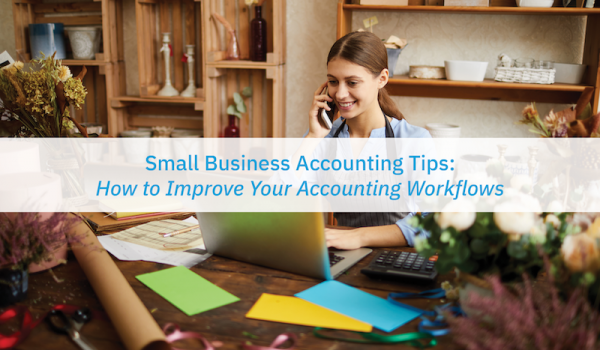
Business workflows are like computer code for people. They direct you and your team with steps to carry out particular tasks. Good accounting workflows turn bookkeeping into a routine task that doesn’t require consistent re-planning and thought. Setting up effective workflows may require some prep work, but you’ll find life gets simpler once they’re in place.
Below, we’ve compiled the most impactful small business accounting tips to streamline your accounting processes and set your team up for efficiency and productivity.
What are Accounting Workflows?
Accounting workflows are procedures for managing a company’s finances. Your workflows might require you to record expenses in Accounts Payable as soon as you incur them or at the end of the working day. Improving them saves time and money, and makes it easy for other team members to step in.
If your bookkeeper or accountant is out for the day or longer, having easy-to-follow accounting workflows in place can keep your business working smoothly. Another employee can step in, follow the instructions, and ensure your organization continues to make progress.
7 Small Business Accounting Tips
Creating and improving your accounting workflows means more than just entering the right numbers in the right ledger. If you want to build efficient workflows, you have to think about your regular business practices and how you manage company funds. The same basics apply whether you’re using a manual system or an automated program such as Accounting Seed.
Here are the top 7 small business bookkeeping tips to build powerful financial workflows for your company.
1. Separate Your Finances
One of the most important steps in improving your workflows is to separate your business finances from your personal finances. If you’re a sole proprietor it’s perfectly legal to use the same checkbook and bank account for your business and personal income. However, even though it’s acceptable, it doesn’t follow the small business accounting best practices.
Separating your business and personal money is efficient. It takes a little work, as you’ll need to open a business checking account. Once you have that, though, you’ll never have to wonder whether that $465 check you wrote last week was used for business, home, or fun.
If you do have to spend your own money for business—say by driving your personal vehicle—always reimburse yourself. This keeps your financial boundaries intact, which is good for tax purposes and can defend you against future legal liability. This is one of the most important small business accounting tips for any new company to follow.
2. Incorporate or Form an LLC
Many small business owners start out as sole proprietors. This status offers several advantages. It’s easy to start, doesn’t require you file papers with the government, and the accounting is simple. Legally, you and your business are the same.
The catch? You can lose your personal assets to business debts or lawsuits. If you form a limited liability company or an S corporation, you’ll protect your personal assets from business debts. This only works if you keep your personal finances completely separate from your company’s. The right accounting workflows can make that separation automatic.
You can separate business and personal accounting with simple steps such as paying business utility bills separately from personal utility bills and applying for credit in the company’s name. Paying yourself a salary or an “owner’s draw” also establishes that you are not your business.
Mingling personal and professional money could void your liability protection too, so it’s important to be vigilant with your accounting. Yet this is one of the easiest startup accounting tips to follow. Just see your state’s steps to form an LLC or S corporation, or ask your accountant for help.
3. Use Software to Follow Accounting Workflows
Accounting firms use dedicated software tools to improve their own accounting workflows. Small businesses can leverage this same software power to improve their own internal workflows and accounting processes.
With the right app, you can get more accounting done in less time and expend less mental effort crunching numbers. Many accounting programs are cloud-based, letting you maintain your workflows from anywhere. One key factor in making this small business accounting tip work is to select a tool that fits your business.
Do You Need Accounting Software for Your Small Business? Read on to find out.
Choose the Right Accounting Software
You’ll get the maximum benefit by choosing the right accounting program. A massive, powerful suite of software often isn’t the best solution. You’re likely to experience better results with a program you can customize to fit your existing business needs and workflows.
One of the other best bookkeeping tips for small business beginners is to choose a flexible accounting program. Accounting workflows that fit when you’re a one-person startup may not cut it when you grow to 100 people on the payroll.
Once you can hand off the bookkeeping to someone else, the right workflows will guide your staff to manage the process in the right way. This key piece of accounting advice for small businesses can save time and money as you scale.
4. Update Ledgers Regularly
Once your business gets busy, you may find it simplest to update your ledgers “whenever.” Closing sales and completing jobs brings in revenue, so those tasks often take priority over bookkeeping. But even if you think you have a handle on the timing, postponing account entries until you have a spare minute can lead to bounced checks and late invoices.
Robust accounting workflows can prevent timing problems by establishing healthy bookkeeping guidelines. For example, you might commit to enter the day’s transactions before you leave work, or you may review the ledgers at the end of every week.
Reviewing accounts for errors should be part of your regular workflows, too. Even if you use accounting software or spreadsheets, entering $400 instead of $4,000 can create a major yet avoidable problem. Following this particular small business accounting tip can save you a significant amount of money with a well-organized general ledger.
5. Workflow Your Routines
Accounting workflows aren’t just for data entry. They also help you keep tasks such as invoicing on track. Whether you send invoices at the time of service, the end of the week, or the end of the month, making it routine makes it easier to maintain consistency.
Having an invoicing workflow also makes it easier to spot problems. Suppose you bill all your clients at the end of the month. That schedule makes it easier to go over accounts receivable and spot late payments than if you billed throughout the month. A good workflow also keeps you on time when you have to submit sales tax or estimated tax payments.
Once you have the right accounting workflows in place, you can assign the accounting to someone else. If they follow your workflows, they should get the same results you would if you were still doing them yourself. This is one of the best time-saving accounting tips for small business owners.
6. Workflow Your Budget
As your business succeeds and grows, you’ll have more routines to manage. Budgeting is one example. Successful businesses make budget projections on a regular basis, whether it’s monthly, quarterly, annually, or all three. At the end of a budget period, companies compare performance to projections and see how close they came.
Making this small business accounting tip work well requires human thought and judgment, but the budget process should be consistent. That’s why having a budget workflow can simplify the work.
For example, let’s say your workflow says you’ll start budget planning by identifying your goals. Is “job one” to grow revenue, cut costs, or invest for future growth? After you decide this, you’ll project your income, cash flow, and expenses. The exact steps will vary from business to business. Once you standardize your accounting workflows, it’s easy to automate them. Learn more in our guide, the Top 16 Benefits of Automating Accounting Processes.
7. Track Expenses, Receipts, and Sales Data
Recording expenses regularly reduces the risk you’ll forget what you spent. Even if you don’t think something’s deductible, when you sit down at tax time you may read about a write-off you didn’t know existed. With good records, a dedicated business account, and a business credit card, you can track every last (potentially deductible) expense.
Setting up a system for tracking and filing receipts helps too. Whether hard copy or digital, develop accounting workflows for filing them. If the IRS questions your spending, the agency will want to see receipts. If your workflows are sound, you’ll be able to find the proof easily.
It’s also a good idea to create a workflow for tracking data about your transactions and customers. For example, if you can see what your biggest customers like or you can spot common patterns for your largest sales, you’ll get valuable clues on how to grow your revenue. With Accounting Seed, transactional data will be automatically pulled into customized financial dashboards, allowing you to make observations on revenue and costs simply and in real time.
Choosing an Accounting Platform
If you’re thinking about automating your accounting workflows, carefully consider both your needs and the features of the tool you’ll buy. Start by understanding what you need from automation and what it can do for you. Are you looking to automate an existing system that already functions well? Or do you need a system to impose workflows on a current state of disorderly bookkeeping?
Ask yourself where automation will provide the most bang for the buck. Routine tasks such as payroll, tracking hours, and processing invoices will adapt to automation easily. By contrast, offering a discount to an angry customer requires human judgment. Budgeting demands a mix of both judgment and automation.
Customizing Your Accounting Software
Getting an accounting software tool to work for your needs and with your established workflows is easier if it’s customizable. One of Accounting Seed’s advantages is that you can customize the software easily. If you want to collect specific financial data, for instance, you can customize Accounting Seed’s dashboards to display whatever information you need, in an easy-to-manage interface.
Customization delivers valuable, detailed business information with much less effort than going through accounts by hand. You can also customize accounting workflow rules with a simple point-and-click system. That makes it easy to tailor the software to your specific challenges and workflows.
To give one example of how Accounting Seed can help small business workflows, the platform makes it easy to enter cash payments. When you record the payment you enter all the relevant information:
- The kind of transaction such as customer payment or vendor refund
- The transaction date and accounting period
- Which ledger to use
- Reference numbers for the check or electronic transaction
- Purpose of the payment
- Bank account
- Cash flow category
- Any added information you might want, such as the related project task
If your requirements go beyond point and click functionality, you can even pay for deeper customization.
If you have questions about choosing a financial software platform or you’d like more small business accounting tips, contact Accounting Seed about booking a consultation or a demo. You’ll quickly see how Accounting Seed can transform your bookkeeping and standardize your accounting workflows.
Read on:
- Top 7 Issues Accountants Face Today
- Accounting Cybersecurity: How to Keep Financial Data Safe and Secure
- DCAA Compliant Accounting Software: What to Look For
- What are the International Accounting Standards (IAS)?
- What is Cash Disbursement in Accounting?
- Accrued Expenses: What are They and How to Report Them?
- Intro to Accounts Payable and Purchase Order Accounting
- Vendor Payment Processes: Everything to Know
- What is Project Accounting? How to Do It Best
A native Salesforce accounting app, Accounting Seed, provides a full 360-degree view of your business’ performance to help you and your team make the best decisions possible. Not on Salesforce? Our software can be customized to work with any system you have through a reliable connection.
See Accounting Seed in action
Get a close-up view of how accounting on Salesforce can eliminate the need for costly integrations—and silos of mismatched information—by sharing the same database as your CRM.




